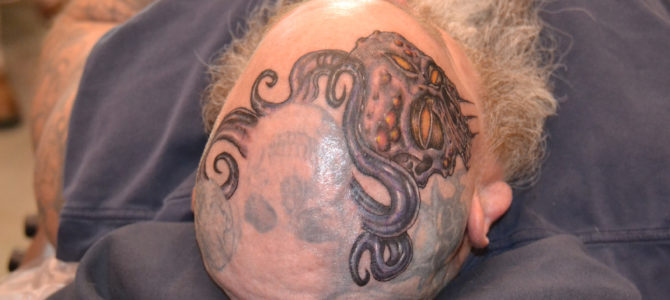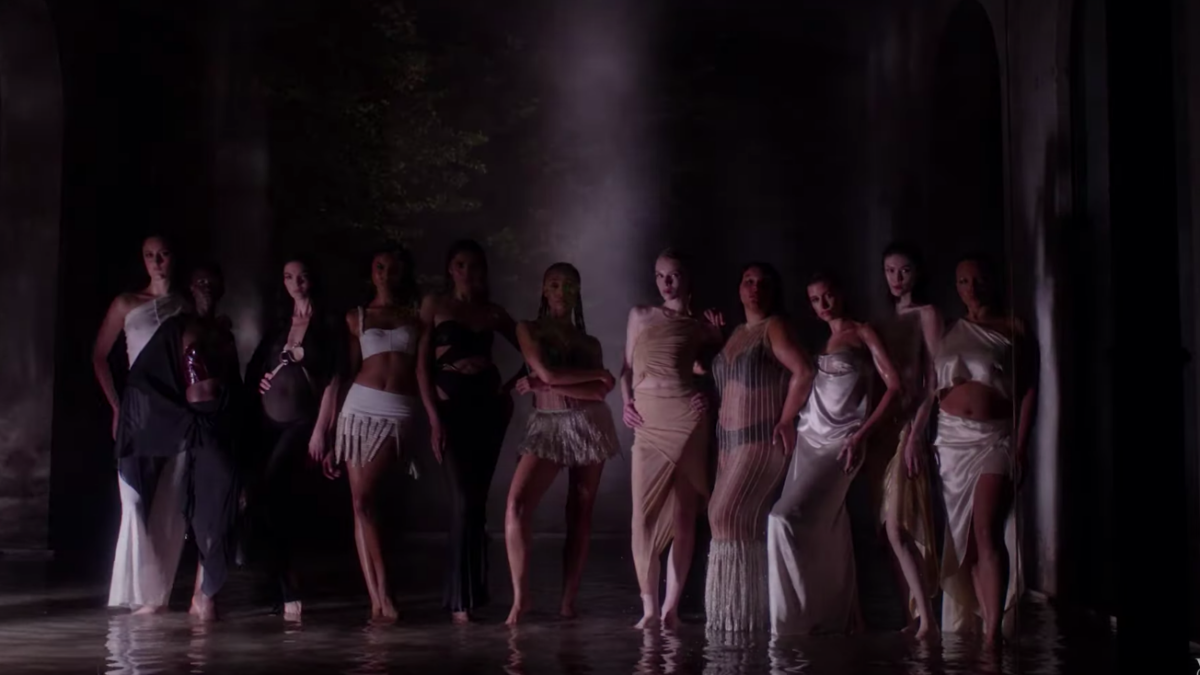For a variety of personal and professional reasons, I did an epic amount of travel in the last year, across thousands of miles and several states, and there was one cultural constant: Everywhere I went were lots of people with tattoos.
And it’s not just that people have tattoos, it’s the tattoos they have. At one point, I found myself in Breckenridge, gawking at the majestic Rocky Mountain scenery—imagine the “Sound of Music,” only swap Julie Andrews singing with a middle-aged dad yelling at the kids to stop complaining about the long drive. The view of the mountain valley was promptly ruined when one of the first things my eyes fixed on after stumbling into the parking lot was an otherwise pretty young girl whose thigh was consumed by a graphic picture of a skull dripping blood.
I’d like to chalk such a sight up to youthful indiscretion and Colorado’s reefer madness, but a few days earlier I’d been in Salt Lake City. I have many relatives in Salt Lake, and I’m fully aware that the town has changed a lot in recent decades. It’s no longer the monochromatic Mormon enclave of my youth where the most outré cultural expression imaginable involved the inadvisable addition of walnuts to Jell-O salad.
Still, that didn’t prepare me for the blond, pony-tailed soccer mom I saw at Costco with a low-cut tank exposing an amazingly detailed tat on her chest exploding into deer antlers crawling across her collarbones. As tattoos go, it was fantastic artistry, and I submit that was the problem. It was so realistic and visually arresting it looked less like a tattoo, and more like a manifestation of Lovecraftian soul-rot spreading onto her shoulders like inky kudzu. Suffice to say, this is quite the juxtaposition to confront when seeing someone hoist bulk food into a cart to feed her innocent munchkins.
You’re Not So Special Anymore, Buttercup
My experience doesn’t seem to be entirely anecdotal. If America can be divided into those who don’t have tattoos and those who do, the two groups seem to be rapidly approaching equilibrium. About one in five Americans have tattoos, and among 18-29 year-olds the latest figures peg those with ink at 40 percent.
Speaking of percentages, the Air Force is so hard up for recruits that it recently eliminated its “25 percent rule.” Like all military regulations, the 25 percent rule is painfully exact, but loosely stated, it meant that you weren’t eligible to serve, much less join a bomber crew ferrying around nuclear weapons, unless you were capable of exercising good enough judgment not to cover more than a quarter of your body in tattoos.
Back in the good old days, the problem was getting tattoos after you joined the military. My dad was a Marine colonel, and believe me, it was a problem. If you’ve never seen the tattoo parlors that set up shop on the edge of a military base, well, don’t. I’m pretty sure you can get hepatitis just by looking at them.
If tattoos were once an act of rebellion against cultural norms, now they are a well-established norm. If you want a tattoo, hey, it’s a free country. But it seems many people still get them laboring under the delusion that they’re a hallmark of individualism. The desire to use visual signals on your skin to proclaim yourself unique to people you don’t even know can’t be terribly healthy. It is, in a subtle and penetrating way, kind of selfish. Or maybe my misanthropy is showing, but the omnipresence of people begging to be noticed for such superficial reasons is surely annoying.
At a baseball game last year, I sat a few rows directly behind a woman with a tattoo on the back of her neck in typewritten script that said, “I’m the hero of this story.” She seemed like a perfectly nice woman—from what I observed, she was also a doting mom—but in these circumstances I was all but forced to stare downward at her tattoo. And the more I thought about the sentiment, the more irritating I found it. It took every ounce of patience within me to make it through nine innings without marching down to her and explaining to this self-proclaimed hero of her story that there’s such a thing as an unreliable narrator.
Where’s The Excitement?
If tattoos ever had a singular redeeming quality, the fact they are now inescapable has robbed them of it. Before everyone had one, seeing one was at least exciting. And you had good reason to surmise there was a story behind it. Maybe your uncle’s career as a salesman at IBM didn’t exactly scream international man of mystery, but when he wore the wifebeater at family cookouts you just knew that guy had some tales to tell about what happened on shore leave.
Of course, tattoos were also seen as exciting in more, um, stimulating ways? I think it was Halloween of ‘97 when a sorority girl in a non-regulation Catholic school uniform leapt up on a table at Rennie’s Landing to show us her tattoo. She was what today’s brosephs would refer to as a “smokeshow,” but alas, this act of youthful abandon was not for my benefit.
While I’d like to claim that the force in the universe responsible for equitably distributing female attention is, to recontextualize Tennessee Williams, a hideous b-tch goddess, the truth is that life’s not fair. My buddy Gordon, sitting next to me, is good-looking enough to have been a male model. However, Gordon was halfway inside a bottle of Wild Turkey and, handsome S.O.B. that he was, so inured to hot girls throwing themselves at him that he left my male gaze unchallenged for the big reveal.
Now, of course, it bears mentioning that as forty year-old man with daughters, the symbolism involved here makes me more than a bit uncomfortable. If you’re really looking to round out the Freudian implications of this little Halloween tableaux, it helps to know that, aside from her being dressed as a schoolgirl, I was wearing zombie make-up. And besides, finding out she had a small heart tattooed on her pelvic bone just below her waistline seems more than a little anti-climactic.
Indeed, the accompanying soundtrack to this recollection that keeps running through my brain is less “Cherry Pie” and more “Is That All There Is?” If the big payoff for intimacy is going to be knowledge of hidden tattoos, at the very least make it useful or instructive. A friend of mine used to threaten that he was going to get a tattoo on his right buttock that read, “If you’re close enough to read this, you’re cooking me breakfast.”
Still, at the time—1997 being a more innocent era, back when lurid tales of presidential sex were still kinda, sorta frowned upon—this dramatic tattoo reveal was still sexy on one level. It raised the suggestion that if a nice sorority girl was willing to do something transgressive like get a tattoo, she would, uh, do other things nice sorority girls weren’t supposed to do.
If my hazy pop culture memories hold, we were only a year or two out from the phrase “tramp stamp” becoming part of the national lexicon. Lower-back tattoos on women eventually became so common they prompted an epic “Saturday Night Live” skit in 2004 mocking them. And lest this degenerate into a discussion about sexism, there have been a number of distressingly overused male tattoo tropes. Right now, there’s probably a guy in a bar—it’s happy hour somewhere—whining that back when he first got it, NO ONE had a tattoo of barbed wire around his bicep.
https://vimeo.com/69310297
But despite some encouraging cultural derision, tattoos still became more overt and common. As a result, any suggestive power tattoos might have had to indicate you’re a sexy badass is as outdated as the thought of Clintons in the White House. They have become so pedestrian, I simply don’t see a way to make tattoos great again.
Bodies In Motion
Now, certainly Americans of all shapes and sizes are fond of tattoos. But it’s also clear that the trend has dovetailed nicely with increased superficial obsession with our appearance. For instance, there seems to be a large overlap between athletes and fitness enthusiasts and people with ink.
I guess that’s one way of drawing attention to the fact you’ve got a rockin’ bod, but in another more important way, it’s kind of a shame. If you view the human form as beautiful, tattoos are a kind of corporeal vandalism. Much of the appeal of sports, for instance, is an almost subconscious appreciation of bodies in motion. Not just any body—bodies that have been chiseled to specific perfection to achieve strength, speed, or both. In that respect, the prevalence of tattoos means that watching the NBA these days is like staring at the Mona Lisa after it’s been tagged.
It’s telling that in the sport most obsessed with perfecting the human form—bodybuilding— tattoos are often cautioned against. “Tattoos can be distracting for judges trying to see a builder’s physique,” cautions one article on the subject from Bodybuilding.com. “The tattoo may obscure the natural contours and shadows created by muscular development.” (Yes, it’s true that bodybuilders are also into things that make their physique unnatural and much unhealthier than getting a tattoo, but purely on aesthetic grounds they have a point.)
If the sheer number of tattoos are a sign we are unhealthily obsessed with our bodies, they’re also a reminder that our bodies are ephemeral. Ever see an old guy with lots of tattoos? Tattoos sink deeper into the skin over time and fade, to say nothing of what happens when your skin inevitably starts to sag or you incur sun damage from years of walking around shirtless to show off your ink. That awesome technicolor screaming eagle on your chest could end up looking not much different than a pre-school watercolor. Oh, and when the tattoo ink starts breaking up as you age, it has a nasty habit of traveling through your body and turning up in your lymph nodes. They’re not important, right?
Of course, if you just have small tattoo or two, these concerns might not amount to much. However, cultural mores on tattoos have shifted rapidly we haven’t really seen a sizable enough percentage of old people with extensive ink to make firm judgments about the regrettable appearance—or just plain regret—related to being all tatted up.
Personally, I suspect that if you want to make a killing, you should move to Boca, open up a tattoo removal clinic, and wait about ten years. You’ll be booked solid for the rest of your life.
But Your Tattoo Is Okay, Right?
Now I realize that inveighing against tattoos in twenty-first-century America is the Little Big Horn of the culture wars, not in the least because so many of you reading this have tattoos and are probably annoyed by this cranky string of get-off-my-lawnisms. I understand people get tattoos for deeply personal reasons. Not all of those reasons are bad or merit the judgment of others.
Every once in awhile, I see someone with a tattoo dedicated to memorializing someone special to them and admire the gesture. And obviously if you are Polynesian and have thousands of years of spiritual tradition behind your tattoos feel free to disregard all of this. (More specifically, if you are a giant Samoan, Tongan, or Maori—are there any other kind?—please don’t hurt me for maligning your cultural heritage.)
A few years back, in a fit of Extreme Parenting, my wife and I hired a nanny off Craigslist without bothering to get any references. This worked out far better than it should have; she turned out to be Mary Poppins reincarnated as an Arizona State sorority girl. The only time we had any doubts about her was when she somewhat reservedly mentioned she had a tattoo of the Waylon Jennings band logo.
We were briefly horrified about the possibility of having hired the Pamela Des Barres of Outlaw Country, but it turns out she was Jennings’ niece. Aside from family pride being an acceptable reason for the tattoo and Jennings being true legend, he makes a good cautionary tale. We encouraged her to tell our kids scary bedtime stories about the horrors of whiskey and cocaine.
A W.A.S.T.E. Of Money
But I still stand by my general assertion that Americans have too many tattoos, even if I understand the impulse to get one. In fact, I think my aversion to tattoos stems, in large part, from the fact I seriously considered getting one. In college, I went through an angsty PoMo literature phase and I thought it would be great to get a tattoo of the muted postal horn symbol from Thomas Pynchon’s inscrutable novel, “The Crying of Lot 49.”
What does it represent? Well, I’ve read the book a few times and… Oh, who knows what it means. The point is that it is cool and “postmodern,” and I thought it’d be a pretty awesome thing to have on my arm as a young man. I imagined I’d get asked about it by women, whereby I’d respond with erudite things like, “Well, Pynchon being one of the great literary interpreters of cold war America’s countercultural tendencies, the symbol represents a fictional conspiracy of…” In retrospect, that’s about as far into my prepared spiel I would have made it before the girl in the Catholic school uniform would have climbed down from the table and filed a restraining order.
In any event, I still spent a few weeks talking to friends about what a tattoo might involve and immediately hit a roadblock. It turns out that tattoos, even small ones, aren’t exactly cheap. I was a broke college student, and a tattoo would put a serious crimp in my plans to subsist on Taco Bell.
Anecdotally, I’ve heard stories of guys at alimony trials being chewed out by the judge for showing up with fresh ink when they claim they can’t pay. A friend of mine recently filled me in on the travails of a rather colorful mutual acquaintance. While the update wasn’t as exciting as previously learning he may or may not have been smuggling gems out of southeast Asia, I was blown away by the expense this fellow was currently taking on to make repeat visits to a renowned tattoo artist in Mexico City.
Your Favorite T-Shirt
Anyway, it was penury, not good judgment, that spared me from getting a tattoo. Not being able to afford one, I decided it would be cool to just have a T-shirt with the muted postal horn symbol on it. With Internet commerce having matured considerably, these days you can order a “Crying of Lot 49” hoodie in seconds. But back then, I would have to have one made by finding someone to silkscreen it, and, well, that would be a lot of effort for a guy who couldn’t be bothered to write term papers prior to the night before they were due.
I do, however, think my tattoo desire would have been satiated by getting a Pynchon T-shirt. Which is ironic, because the best explanation of tattoos I’ve ever heard was from someone on Facebook who put the problem of tattoos this way: “Imagine having a favorite T-shirt. Now imagine having to wear that shirt every day for the rest of your life.” At some point, it would cease to be your favorite T-shirt, right?
Along these lines, I refuse to believe even a sizable percentage of tattoos have been worthy decisions. For some select people, maybe tattoos are small part of their grand plan to live life to the fullest. But the vast majority of people should be encouraged to lead exciting and meaningful lives without needing to, in some cases literally, tattoo their personal vanity and insecurity right on their forehead. Fortunately, for now forehead tattoos still make you a bit of a pariah—after all, even the Air Force still has some standards.









